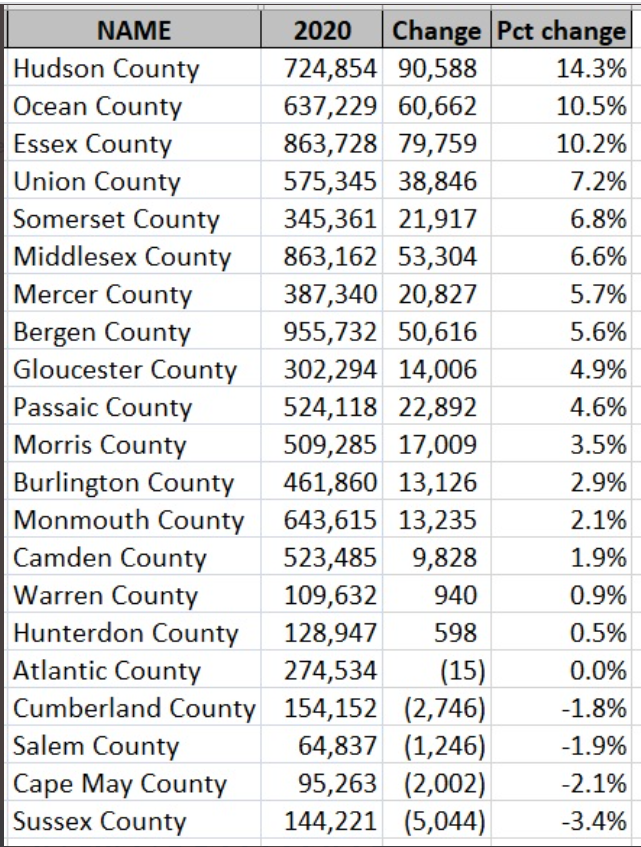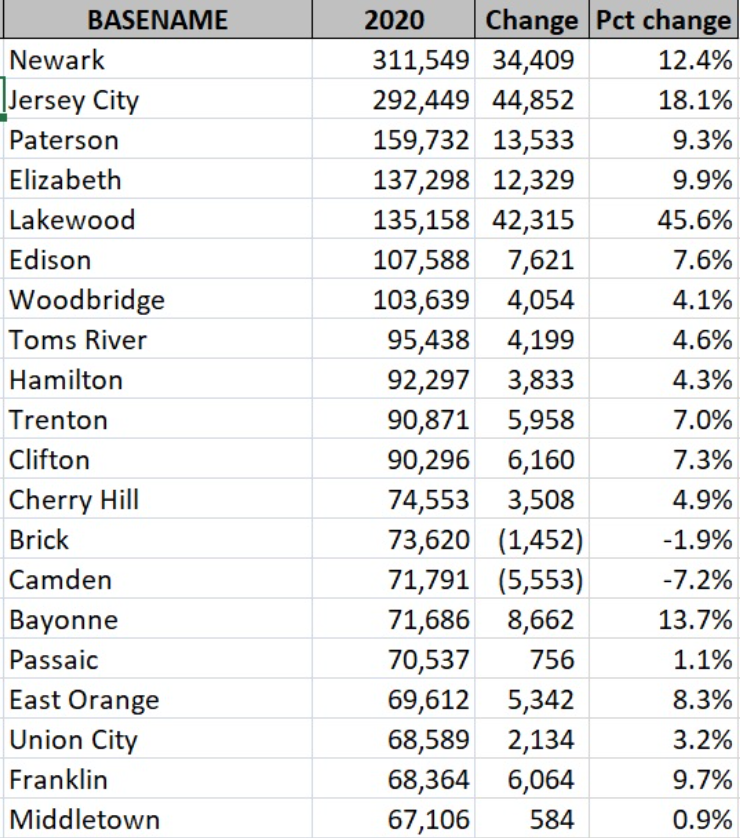2020 Census: Newark Most Populous City in New Jersey and Other Redistricting Nuggets


Newark officially ranks as New Jersey’s most populous city, according to the 2020 Census,

“However, the most important results of the 2020 Census are not if our city is the largest in New Jersey, but that our increasing number of residents… receive every resource we need to deliver vital services.”
outnumbering second place Jersey City: 311,549 to 292,449, in a state with one of the highest diversity indexes in the country (see above) with a population that grew by 5.7% over the past decade.
Heading into 2021 redistricting, New Jersey (pop. 9,288,994) is one of just eight states (including the District of Columbia) nationwide with a diversity index above 65%. In New Jersey, non-Hispanic whites clock in at 51.9% of the population – down from 59.3% in 2010. Just 31 of New Jersey’s 40 state senators are white; 56 of the state’s 80 assembly people are white. The 2020 national diversity index in the U.S. came in below New Jersey’s, at 61.1 percent, up from 54.9 percent recorded in 2010.
Among New Jersey’s 21 counties, Hudson experienced the largest growth spurt over the last ten years, followed by Ocean (see below).
From Patrick Murray of Monmouth University, via NJ.com:
“The U.S. Census Bureau has finally released the data states need to carry out redistricting. That sets a number of processes in motion for the commissions responsible for redrawing New Jersey’s congressional and legislative districts.
“Despite the six-month delay, our process is pretty much on track. The Redistricting Commission, which draws the congressional map, is not required to deliver a final map until mid-January.
“The Apportionment Commission — the body responsible for redrawing the state legislative map — could have been in trouble since the election for those offices is less than three months away. However, a constitutional amendment approved by voters last year allows the state to delay the implementation of a new map until 2023.”
Former state Supreme Court Justice John Wallace Jr. will serve as the 13th, tie-breaking member of the congressional redistricting commission, according to a decision rendered last week by the state Supreme Court.
The commission will redraw the state’s 12 congressional districts ahead of the 2022 midterms.

A separate, legislative redistricting commission – with presumably a state supreme court-appointment tiebreaker – will also convene on the heels of today’s 2020 census data dump to redraw legislative districts based on population changes over the last ten years.
Ten years ago, diversity representation drove the debate, and Democrats won with a map that promoted Latina Nellie Pou to the state senate in the name of increasing the state’s expanding Hispanic population, and retired state Sen. John Girgenti.
On the congressional side this year, U.S. Rep. Tom Malinowski (D-7) radiates vulnerability as a congressional Girgenti.
It’s not a naturally 10-2 state, Republicans to Democrats and the Central Jersey congressman will have a difficult time, given the ongoing theme of diversity and New Jersey hovering right at the razor’s edge of being a majority minority state, convincing people he will be more necessary than his colleagues, U.S. Rep. Andy Kim and U.S. Rep. Mikie Sherrill.
“Malinowski’s at risk,” said an insider. “He’s in trouble, there’s no question.”
Democrats will be trying to make sure Kim not get more Republican heavy Ocean County and that Sherill gets a D-registration bounce.

“Malinowski becomes an easy sacrifice,” said the source.
On the legislative side, a Democratic source said he anticipated the GOP to make a push in the south, given the population growth spurt in Ocean (see below). Pointing to lost population in Sussex, at least one Republican source described what he anticipated might be a Democratic effort to pit state Senator Steve Oroho (R-24) against state Senator Mike Doherty (R-23) in an all-GOP gladiatorial contest, with the Democratic-establishment-friendly Oroho given the edge with a map in his favor to jettison the always-off-the-reservation Doherty.
For his part, Democratic State Party Chairman LeRoy Jones has consistently described his priority in the role of redistricting chairman as protecting incumbents.
The Wallace for tiebreaker pick by Chief Justice Stuart Rabner may pressure the judge to pick a Republican leaning choice to balance out advantage Dems on congressional redistricting. He also may feel pressure to pick a woman, a source noted.
Because of delays caused by COVD, redistricting – legislative and congressional – will run concurrently this year, as opposed to sequentially. The processes overlap in more ways than just time. If congressional redistricting ultimately favors Kean (a longtime Trenton denizen), the trade-off may give legislative Democrats a chance to grab a “minority” seat in population-bulked Hudson or Essex while mashing Doherty and Oroho (again, advantage Oroho) in Western New Jersey, where population dipped.

County growth chart, via Mike Symons of 101.5 FM:

A chart of 2010-2020 population growth in New Jersey’s biggest municipalities, also via Mike Symons of 101.5 FM:









Leave a Reply